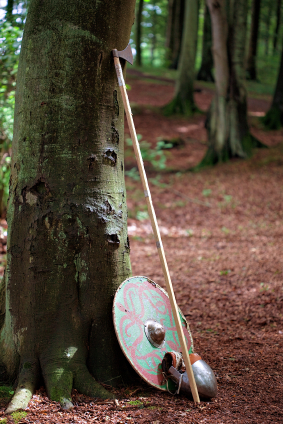The pharaoh Tutankhamun ruled ancient Egypt during the 18th dynasty of the New Kingdom (circa 1550–1295 BC), one of the most powerful royal houses in ancient Egypt. Although he sat on the throne for only 9 years and died at the young age of 19, he is one of the most well known pharaohs, due largely in part to the discovery of his intact tomb by archaeologist Howard Carter in 1922. The tomb was filled with riches befitting a king, including an elaborate sarcophagus with a gold burial mask and statues of ancient Egyptian gods such as Osiris and Anubis, as well as gold jewelry, statues and images of servants, ornate furniture, models of boats and other items that the pharaoh would need in the afterlife. A lesser known item discovered in his tomb was an undecorated wooden box in which two small gilded coffins lay side by side. These coffins held the mummified remains of King Tutankhamun’s two stillborn daughters. Recently, researchers examined these remains in detail to determine their gestational ages and characterize any congenital abnormalities that they might have inherited from the boy king.
Continue reading “The Daughters of King Tutankhamun”Author: Terri Sundquist
A Scientist’s Rant about the Word “Theory”
I have many pet peeves in my life. Because I am a scientific editor, many of my pet peeves revolve around abuse of the English language. The abuse that set me off most recently is the misuse of the word “theory”. These days everyone has a theory about something. For example I have a “theory” as to why I gained five pounds over the holidays: Too much rich food and egg nog! However, from a scientific standpoint, saying “I have a theory as to why I gained five pounds over the holidays” is not a proper use of the word theory. While it is likely that the food and egg nog contributed to the weight gain, I do not have a theory. The cause of the weight gain has not been scientifically scrutinized and put through rigorous testing. There isn’t a pile of scientific evidence to support my statement. What I have is a sound working hypothesis, not a theory.
Continue reading “A Scientist’s Rant about the Word “Theory””Targeted Medicine: Using Bacteria as Navigators

[Yawn] Another bacterial strain in a world where bacteria are one of the most abundant life forms. Ho hum, right? Not so fast! Wait until you see what these bacteria—or more specifically, the magnetosomes—can do. Magnetotactic bacteria might provide us with a great new tool to target delivery of chemotherapeutic drugs, recombinant proteins and medically relevant antibodies, ligands and nucleic acids to treat a wide range of diseases. Continue reading “Targeted Medicine: Using Bacteria as Navigators”
Another Application for DNA Testing: Getting the Scoop on Dog Poop
 As a society, we love our pets. In many cases, cats and dogs are our surrogate children. We spoil them with treats, toys and plenty of attention. They reward us with unconditional love (or as some cats seem to think, simply with their presence). However, in addition to the many joys of animal companionship, there are unpleasant effects and responsibilities associated with pet ownership. Cat or dog hair covers our furniture, our favorite sweater and every other possession, whether or not these items come into direct contact with our hairy friend. Some dogs have uncontrollable urges to chase cars or bark incessantly; cats often dispense fur balls randomly around the house or become a pest every time we use the can opener. One of the worst responsibilities, in my opinion, is cleaning up after them. Cats have litter boxes, which must be cleaned periodically, and dogs generate piles of yesterday’s dog food, which must be picked up. A responsible dog owner even carries plastic bags during walks to collect piles that Fido leaves along the way. However, not all pet owners are responsible enough to pick up the offending material, and this is causing problems in many communities. Some property owners are now implementing a high-tech solution to this unsightly problem: DNA testing.
As a society, we love our pets. In many cases, cats and dogs are our surrogate children. We spoil them with treats, toys and plenty of attention. They reward us with unconditional love (or as some cats seem to think, simply with their presence). However, in addition to the many joys of animal companionship, there are unpleasant effects and responsibilities associated with pet ownership. Cat or dog hair covers our furniture, our favorite sweater and every other possession, whether or not these items come into direct contact with our hairy friend. Some dogs have uncontrollable urges to chase cars or bark incessantly; cats often dispense fur balls randomly around the house or become a pest every time we use the can opener. One of the worst responsibilities, in my opinion, is cleaning up after them. Cats have litter boxes, which must be cleaned periodically, and dogs generate piles of yesterday’s dog food, which must be picked up. A responsible dog owner even carries plastic bags during walks to collect piles that Fido leaves along the way. However, not all pet owners are responsible enough to pick up the offending material, and this is causing problems in many communities. Some property owners are now implementing a high-tech solution to this unsightly problem: DNA testing.
Continue reading “Another Application for DNA Testing: Getting the Scoop on Dog Poop”
Autopsy Results of a 5,300-year-old Murder in the Italian Alps
A Neolithic man who died a violent death high in the Ötztal Alps has been thawed for the first time in 5,300 years, and his autopsy is revealing new clues as to how he lived and died. The mummified body of the man, nicknamed Ötzi, was first discovered partially embedded in a glacier in September of 1991 by two German hikers, and due to the initial assumption that he was a modern corpse, was hastily extracted from the ice by Austrian authorities and taken to a morgue in Innsbruck. Only then did scientists learn Ötzi’s true age and historical significance as the oldest natural European mummy from the Copper Age.
Vikings in the British Gene Pool

Not My Shade of DNA
 DNA testing is providing some answers in a nine-month campaign of hate and revenge involving two British women: a wife and her husband’s mistress. Between May of 2010 and February of 2011, the wife was stabbed in the stomach with a screwdriver, had bleach thrown in her face, received death threats in the mail, been the victim of an arson attack and had a threatening message written on her apartment window in lipstick. She blamed the mistress in her reports to police. As a result, the mistress had been arrested numerous times and spent 20 hours in police custody despite her assertions that she was not involved in any of the attacks. The situation became so maddening that her family started a diary of her whereabouts to help prove her innocence.
DNA testing is providing some answers in a nine-month campaign of hate and revenge involving two British women: a wife and her husband’s mistress. Between May of 2010 and February of 2011, the wife was stabbed in the stomach with a screwdriver, had bleach thrown in her face, received death threats in the mail, been the victim of an arson attack and had a threatening message written on her apartment window in lipstick. She blamed the mistress in her reports to police. As a result, the mistress had been arrested numerous times and spent 20 hours in police custody despite her assertions that she was not involved in any of the attacks. The situation became so maddening that her family started a diary of her whereabouts to help prove her innocence.
Hoping to find some physical evidence that might shed some light on the events, police examined the evidence in the case more closely. This included DNA analysis of the lipstick used to write the threatening message and saliva used to seal the envelope containing the death threats. The results of the DNA analysis were shocking. Continue reading “Not My Shade of DNA”
How to Catch a Serial Killer
 “[I]deas about who killed whom does not come to the criminal profiler in flashes of insight, nor does a group of FBI profilers fly around the country in a Lear jet and solve heinous murders within a few days with the help of a computer genius back in Quantico who seemingly has unlimited resources and who admittedly conducts illegal hacking into data banks that are highly confidential.”
“[I]deas about who killed whom does not come to the criminal profiler in flashes of insight, nor does a group of FBI profilers fly around the country in a Lear jet and solve heinous murders within a few days with the help of a computer genius back in Quantico who seemingly has unlimited resources and who admittedly conducts illegal hacking into data banks that are highly confidential.”
This excerpt from a recent Forensic Science International paper (1) pokes fun at criminal profiling as portrayed on television shows such as Criminal Minds. However, this is just another example of Hollywood producers embellishing reality and stretching the truth to try to increase the entertainment value. [To learn about how the television show CSI has warped public perception of the forensic sciences, check out The Reality of Crime Scene Investigation. Part I: Common Myths].
So, if these Criminal Minds and CSI approaches to catching murderers aren’t accurate, how do law enforcement officers identify killers and bring them to justice? Continue reading “How to Catch a Serial Killer”
Does Your Daily Cup of Coffee Affect Your Risk of Cancer?
 Is there an association between coffee consumption and incidence of cancer? The answer seems to depend on whom you ask, the study group involved, how much and what type of coffee the study participants drank and a host of other factors. Many research studies have found no link or only a weak link between the two, but recently a new study that showed a stronger association between coffee consumption and a lower risk of prostate cancer was published in the Journal of the National Cancer Institute (1). Why should we believe this new study when so many other studies have been unable to show a strong link?
Is there an association between coffee consumption and incidence of cancer? The answer seems to depend on whom you ask, the study group involved, how much and what type of coffee the study participants drank and a host of other factors. Many research studies have found no link or only a weak link between the two, but recently a new study that showed a stronger association between coffee consumption and a lower risk of prostate cancer was published in the Journal of the National Cancer Institute (1). Why should we believe this new study when so many other studies have been unable to show a strong link?
Continue reading “Does Your Daily Cup of Coffee Affect Your Risk of Cancer?”
The Link Between Childhood Adversity and Cellular Aging
 Adversity and stress are known risk factors for psychiatric disorders, cardiovascular and immune disease, cognitive decline and other health problems. The long-term negative effects of adversity seem to be greatest if the traumatic events were experienced during childhood, when the brain and other biological systems are developing and maturing. Researchers are working to identify the mechanisms involved and have identified telomere shortening as one possible mechanism by which adversity increases morbidity and mortality. Continue reading “The Link Between Childhood Adversity and Cellular Aging”
Adversity and stress are known risk factors for psychiatric disorders, cardiovascular and immune disease, cognitive decline and other health problems. The long-term negative effects of adversity seem to be greatest if the traumatic events were experienced during childhood, when the brain and other biological systems are developing and maturing. Researchers are working to identify the mechanisms involved and have identified telomere shortening as one possible mechanism by which adversity increases morbidity and mortality. Continue reading “The Link Between Childhood Adversity and Cellular Aging”



